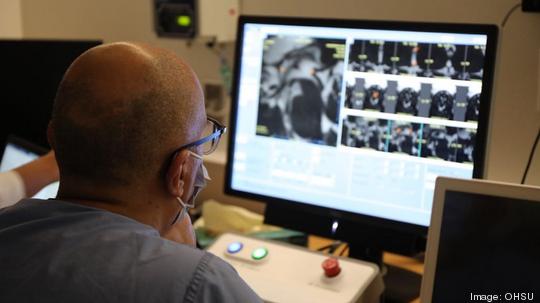
In late March, OHSU Hospital became the first center in Oregon, and one of 30 in the U.S., to offer a brain surgery that uses high-frequency sound waves and requires no incisions into the skull.
Dr. Ahmed Raslan has now performed four such procedures, and he expects to do more and more focused ultrasounds. We spoke with him about what it took to establish the program and how the technology works.
What it involves
The FDA approved focused ultrasound for clinical use in 2016 for the treatment of essential tremor and tremor-dominant Parkinson’s disease. The patient is fitted with frame attached to special helmet that contains 1,000 high-frequency sound beams delivered with pinpoint precision by an MRI through the skull, Raslan said. The sound waves burn a lesion into the focal point deep within the brain causing the tremors, just a few millimeters wide.
“The sound energy converges into thermal energy, heat energy, and produces the lesion instantaneously,” Raslan said.
What it took to launch
Raslan had been working for a year and a half to bring the Exablate Neuro platform, which cost $2.1 million to acquire, to OHSU. Engineers from the manufacturer, Israel-based InsighTec, did a site visit to assess OHSU's setup. First, an MRI was installed that would be compatible with the platform. Raslan and his team of providers, including MRI technologists, underwent training and visited Kansas City to see the machine in action.
“There were about four sessions of rehearsal and training for all parties involved,” Raslan said.
They created a website and information page for patients and drew up a “clinical pathway” to guide who would be a good candidate for the procedure, Raslan said.
How many could benefit
There is currently a waiting list of 60 patients. At this point, Raslan does two on a single day every two weeks, or four per month. He expects to double that to eight a month, or about 100 per year. Medicare covers the procedure in Oregon for essential tremors but not yet for Parkinson’s.
Raslan expects the technology to be used for other conditions, including epilepsy.
The risk
Since there’s no cutting, there’s also no risk of bleeding or infection.
“It’s a comparatively lower risk, but it has a risk because you’re delivering an external energy into the brain,” Raslan said.
Success
All four patients who underwent the procedure experienced immediate results, Raslan said. The first one, a 73-year-old woman from Madras, Oregon, had developed an uncontrollable tremor in her hands four years ago. After the three-hour procedure, she was able to hold her right hand steady.
“It’s gratifying and humanizing,” Raslan said. “You see people tearing up, claps and joy. These are not mundane things. Our patient held a glass of sparkling cider for the first time in four years. That was a priceless moment.”



